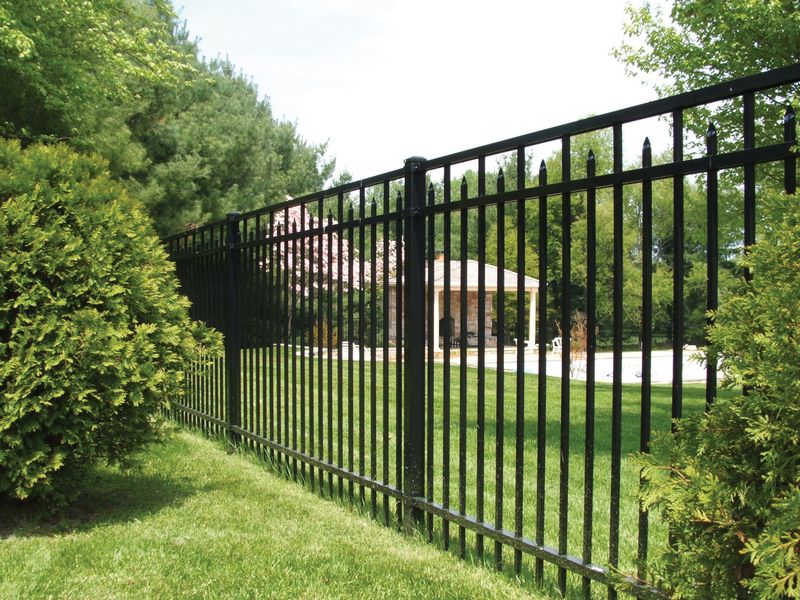At Fencing Direct, we understand the importance of making environmentally conscious choices, especially when it comes to home improvements. Our vinyl and aluminum fences are not just durable and aesthetic but also a more sustainable choice for your property compared to traditional wood fencing.
Environmental Impact of Vinyl and Aluminum vs. Wood Fencing
To maintain a wood fence, you have to use stains and chemicals, many of which can be harmful to both the environment and your health. These treatments typically contain volatile organic compounds (VOCs) and other toxic substances. When you apply these treatments, it’s best to use protective gear, such as N95 masks. These chemicals can leach into the soil and affect local ecosystems and potentially enter water sources.
In contrast, vinyl and aluminum fences present a more environmentally friendly and health-conscious alternative. These materials do not require the same level of chemical treatment for maintenance. Unlike wood, which is susceptible to rot, decay, and insect damage, vinyl and aluminum are inherently more durable. This durability eliminates the need for the use of harmful chemicals at all.
A Longer Lifespan Means Less Materials
The longevity of materials significantly impacts a fence’s environmental footprint. Even with meticulous care and regular maintenance, a wood fence typically lasts about 10 years before showing signs of wear and tear such as rot, warping, or insect damage. This limited lifespan means you may need to replace your wood fences relatively frequently. Each replacement cycle contributes to environmental strain. The production, transportation, and installation of new fencing materials consume resources and energy, while the disposal of old fencing contributes to waste and potential pollution.
In contrast, vinyl and aluminum fencing are renowned for their durability, often lasting several decades with minimal maintenance. This resilience translates to a significantly longer lifespan, reducing the frequency of fence replacements. Consequently, the environmental impact associated with the manufacturing and disposal processes is considerably lessened.
The Rising Concern with Wood
The environmental sustainability of wood fencing has become a growing concern in recent years. Many lumber companies do not adhere to sustainable wood collection methods. This unsustainable practice leads to the depletion of forests, which are vital not only for biodiversity but also for carbon sequestration, a critical process in mitigating climate change.
Economically, the impact of these practices is reflected in the rising costs of wood, particularly high-quality varieties like cedar. The increasing scarcity of cedar and other preferred fencing woods is a direct consequence of overharvesting and insufficiently managed forestry practices. This scarcity drives up prices, making wood fencing a less affordable option for many homeowners.
The Benefits of Choosing Vinyl & Aluminum for Sustainability
At Fencing Direct, we proudly offer vinyl fencing as a sustainable choice. Our commitment to the environment is evident in our choice of materials, particularly in our use of recycled vinyl. In an impressive feat of sustainability, our supplier successfully recycled 38 million pounds of vinyl/PVC in 202. This substantial effort in recycling demonstrates dedication to reducing waste and a commitment to promoting sustainable practices in the fencing industry. By choosing recycled materials for our vinyl fences, we actively participate in the circular economy, where materials are reused and repurposed, thereby minimizing our environmental footprint.
Our decorative screens, a popular choice among our range of products, are a testament to this commitment. These screens are manufactured in facilities where eco-consciousness is not just a buzzword, but a guiding principle. In these facilities, an astounding 99% of scrap materials are recycled. This high rate of recycling ensures that almost every bit of material is reused or repurposed.
Innovative Powder Coating: Revolutionizing Aluminum Fence Finishing
One of the standout features of our aluminum fences is the use of an advanced powder coating process. This modern technique is a significant improvement over traditional liquid paint finishes. Powder coating involves applying a dry powder to the metal surface, which is then cured under heat to form a skin-like layer. Remarkably, the powder coating process reduces carbon emissions by an impressive 60% compared to traditional liquid paint methods.


